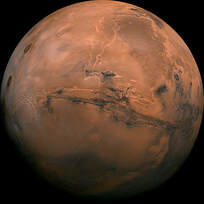MARS
|
Mars is the farthest rocky planet from the Sun and is about half the size of the Earth. Its poles are covered by water ice and frozen carbon dioxide. Dry river beds and ancient coastlines are scattered across its cratered surface. Huge seasonal dust storms can cover the entire planet and last for months. Mars has the largest volcano in the Solar System called Olympus Mons. It is three times higher than Mt. Everest and would stretch from Lethbridge to Regina!
|

